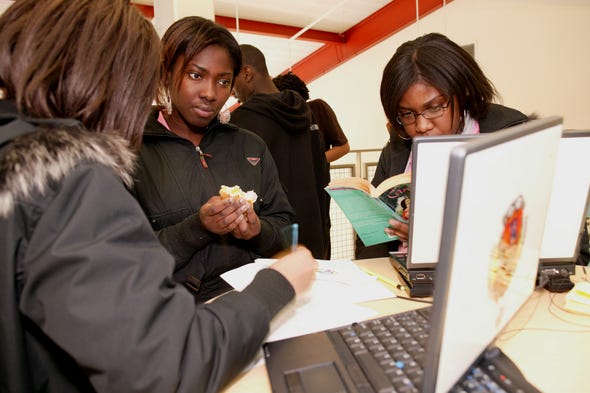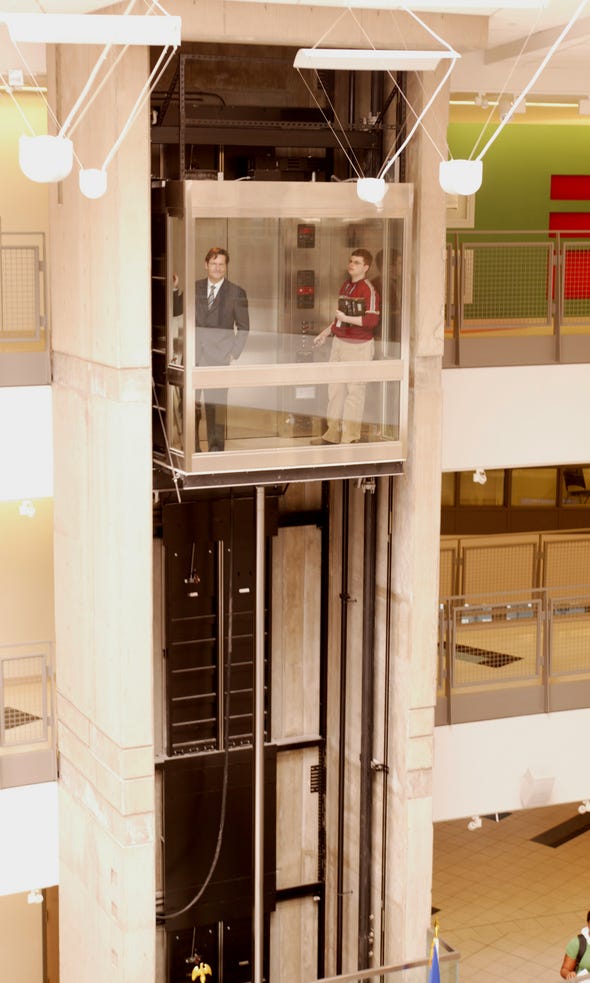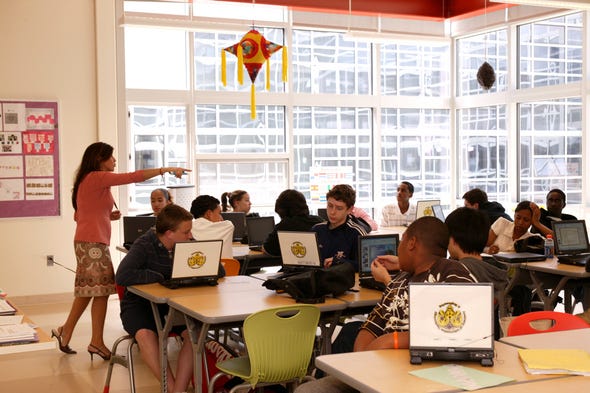High Tech High School Preps Students For IT Careers
An innovative public high school in Connecticut connects with students who yearn to learn about technology, information systems, engineering, and digital electronics.

Dylan Sodaro doesn't mind waking up at 5:30 a.m. for school and staying as late as 6 p.m., when he says goodbye to janitors on the night shift.
| |
| |
"I like going to school and I'm upset when we have days off," he said.
The 16-year-old spends his days learning in classrooms with floor-to-ceiling windows and Internet access at nearly every desk. Like many other students who spend their days at the Academy of Information Technology and Engineering (AITE) in Stamford, Conn., he doesn't think twice about going the extra mile to attend the college preparatory magnet high school.
"I love the majority of the teachers," Sodaro said during a recent interview. "I love my friends. That's the best part, and, overall, it's a fun place to be."
Sodaro, his friends, his teachers, and his school are among people and schools defying studies that increasingly show U.S. students lag behind their peers in other countries in science, technology, engineering, and math. They are interested in current affairs, international politics, travel, math, science, and technology, and much of the credit is due to the school's architects and administrators.
AITE isn't like other schools.
It's not built of cinderblocks painted in drab, institutional colors, and it's not lit by buzzing fluorescent lights.
Its hallways and 40 classrooms fill with natural daylight. Every student gets a school-issued laptop and they can connect to the Internet with Wi-Fi signals in an outdoor amphitheater designed like a lecture hall. Parents pay $75 to insure and maintain the HP swivel-design tablet laptops, which encourage students to retain penmanship and come installed with LoJack theft protection software.
Principal Paul Gross said the design of the building matches the spirit and philosophy of the school. The Bronx native is determined to provide students with an education that emphasizes thinking critically, problem-solving, mastering technology, becoming bi- or multi-lingual, and demonstrating social accountability.
Classes are 88 minutes long. Six students interviewed recently said they have no trouble focusing on their lessons for the duration. Teachers with professional backgrounds in the subjects that they teach demonstrate creative methods -- like tossing a rock at a classroom door -- to grab and keep students' attention.
| |
| |
The school offers over 600 students more than 30 IT electives, including architectural design, CAD technology, civil engineering, geographic information systems, Web production, robotics, pre-engineering, and digital electronics. Students who want to take classes that aren't offered at the school may take virtual classes online. Advanced Placement (AP) classes are offered by the University of Connecticut, Norwalk Community College, and the University of New Haven.
The State of Connecticut fully funded the $42 million building, which opened last Fall. Fuller and D'Angelo Architects and Planners created an open, modern, and cheerful atmosphere with skylights, an atrium, five science labs, five computer labs, a cyber café, a media center, three music suites, and a dance studio. The building won an "Educational Design Excellence Award" from American School & University magazine.
Internships, Job Offers From Major IT Companies
Each of the classrooms and even conference rooms are equipped with DVD players, document cameras, LCD projectors, and enough connections and outlets for teachers and students to plug in for PowerPoint presentations or note-taking. Students attending animation classes have access to Macs. Students preparing for Cisco certifications in networking learn in labs with exposed wires and data centers and actually help maintain the school's networks. Some have internships with the City of Stamford and job offers from major IT companies that offer college assistance and work, beginning the day after graduation.
Parts of the 121,000-square-foot building's infrastructure, including air ducts, wires, and a central elevator, are deliberately and cleanly exposed so students can better understand architecture and engineering. A thermal storage system harvests and stores energy during low-use times and releases it for daytime. Special shades and lighting are integrated with light sensors to control the amount of daylight streaming in, reducing energy consumption and computer screen glare.
The architects said they aimed to give the three-story building a communal feel similar to the Piazza. They created open courts and bridges inside a building sculpted to respond to art, architecture, and engineering.
Although the building is new, the high school opened eight years ago and shared space with a middle school. It attracts students from nearby districts who apply through a lottery system. AITE accepts students at all performance levels -- as long as they commit to the school's high standards.
| |
| |
About 49% of the students are white and the rest are mostly African-American and Hispanic. About 65% of the students are boys, but Gross is trying to change that by targeting girls in recruitment efforts. He said it helps to bring along female students, but many teenage girls are reluctant to leave their social circles at other schools.
"I Don't Feel Intimidated"
Nadya Ali, a 17-year-old AITE student who said science is probably her strongest subject, believes that fewer women are drawn to math and sciences because the fields are dominated by men.
"Last year I had to write an essay about that," she said. "I don't feel intimidated, but I think [some girls are] because women have been suppressed for so many years."
Yu Xiao Zhao, a senior, disagreed.
"I think it's because they're less interested in those subjects," he said, beginning a debate that began with giggles and ended with students agreeing that a teacher has to get students involved and make lessons fun for everyone.
Students easily rattle off several names when asked which teachers make their classes most fun. And, their conversations move seamlessly across a variety of topics that include their own schedules, college applications, plans to travel abroad, and the plight of refugees in Darfur.
During the dot-com boom, the high school aimed to prepare students for technology careers in Stamford, but Gross altered the curriculum to reflect globalization and increased competition. The school maintains a focus on science, technology, engineering, and math (STEM), but students must also take four years of English, math, social studies, science, and a choice of French, Spanish, Latin, Mandarin, Russian, or Arabic.
Gross said that when American students visit foreign countries, a disadvantage is evident as they encounter teens who speak three or four languages.
The school's architect, Joseph Fuller, Jr., A.I.A., EVP of Fuller D'Angelo, said that a Chinese delegation from Stamford's sister city recently visited and AITE students greeted them in Mandarin.
"They were floored," he said. "It was really special."
Gross said that he tries to use the students' interest in technology to encourage them to learn about current events and connect with other children from around the world. Half the courses rely on online textbooks and students who miss classes can check lessons and homework assignments on their teachers' Web pages.
"These children now and, in future generations, are going to be digital masters," he said.
About the Author(s)
You May Also Like
How to Amplify DevOps with DevSecOps
May 22, 2024Generative AI: Use Cases and Risks in 2024
May 29, 2024Smart Service Management
June 4, 2024









